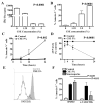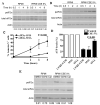Effects of cigarette smoke extract on primary activated T cells
- PMID: 23665673
- PMCID: PMC3676722
- DOI: 10.1016/j.cellimm.2013.04.005
Effects of cigarette smoke extract on primary activated T cells
Abstract
Tobacco smoking predisposes the development of diseases characterized by chronic inflammation and T cell dysfunction. In this study, we aimed to determine the direct effects of cigarette smoke on primary T cells and to identify the corresponding molecular mediators. Activated T cells cultured in the presence of cigarette smoke extract (CSE) displayed a dose-dependent decrease in cell proliferation, which associated with the induction of cellular apoptosis. T cell apoptosis by CSE was independent of caspases and mediated through reactive oxygen and nitrogen species endogenously contained within CSE. Additional results showed that exposure of T cells to CSE induced phosphorylation of the stress mediator eukaryotic-translation-initiation-factor 2 alpha (eIF2α). Inhibition of the phosphorylation of eIF2α in T cells prevented the cellular apoptosis induced by CSE. Altogether, the results show the direct effects of CSE on T cells, which advance in the understanding of how cigarette smoking promotes chronic inflammation and immune dysfunction.
Copyright © 2013 Elsevier Inc. All rights reserved.
Figures



References
-
- Alberg AJ, Samet JM. Epidemiology of lung cancer. Chest. 2003;123:21S–49S. - PubMed
-
- Anto RJ, Mukhopadhyay A, Shishodia S, Gairola CG, Aggarwal BB. Cigarette smoke condensate activates nuclear transcription factor-kappaB through phosphorylation and degradation of IkappaB(alpha): correlation with induction of cyclooxygenase-2. Carcinogenesis. 2002;23:1511–1518. - PubMed
-
- Adcock IM, Caramori G, Barnes PJ. Chronic obstructive pulmonary disease and lung cancer: new molecular insights. Respiration. 2011;81:265–284. - PubMed
-
- Mannino DM, Buist AS. Global burden of COPD: risk factors, prevalence, and future trends. Lancet. 2007;370:765–773. - PubMed
-
- Sethi JM, Rochester CL. Smoking and chronic obstructive pulmonary disease. Clin.Chest Med. 2000;21:67–86. viii. - PubMed
Publication types
MeSH terms
Substances
Grants and funding
LinkOut - more resources
Full Text Sources
Other Literature Sources

